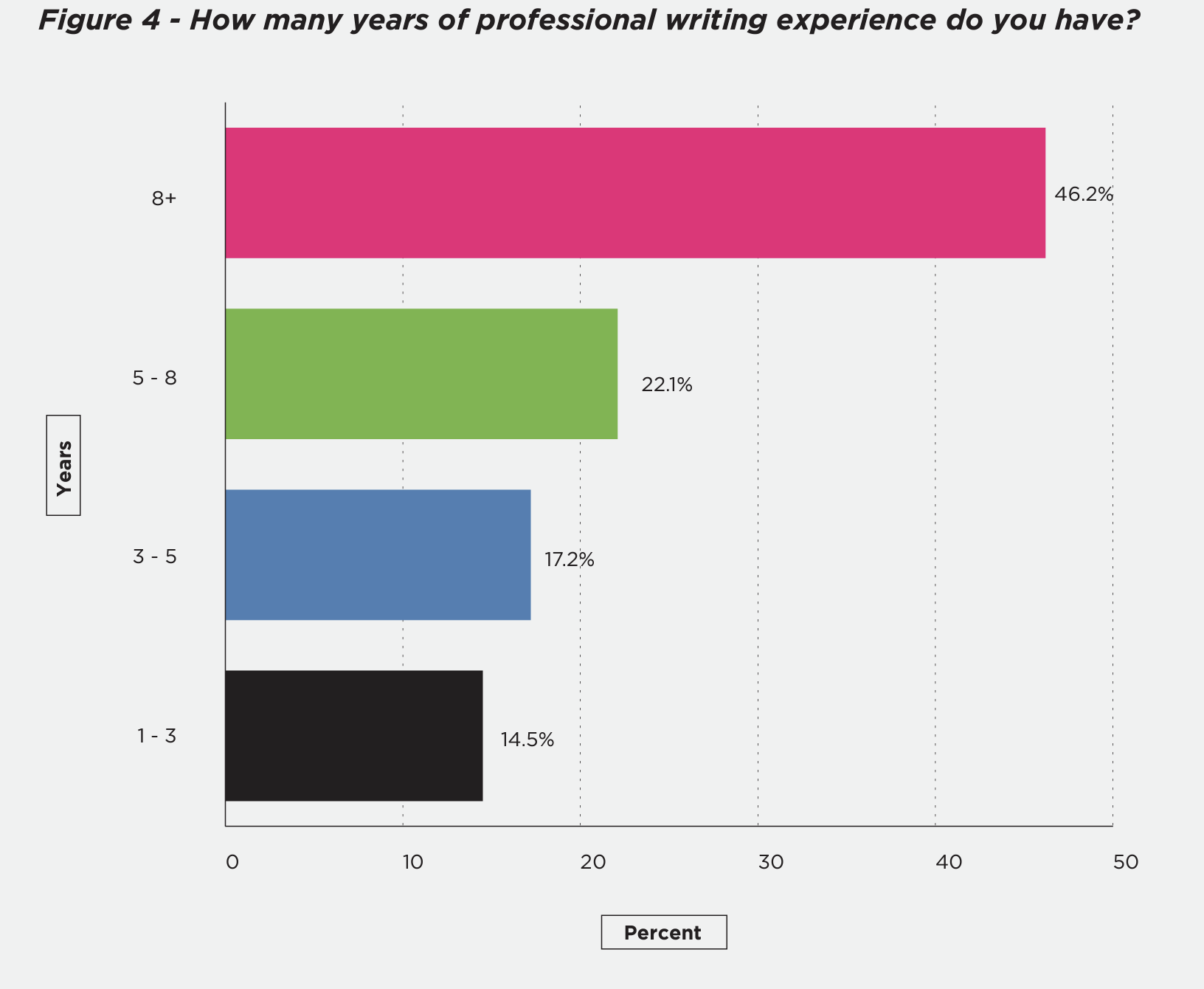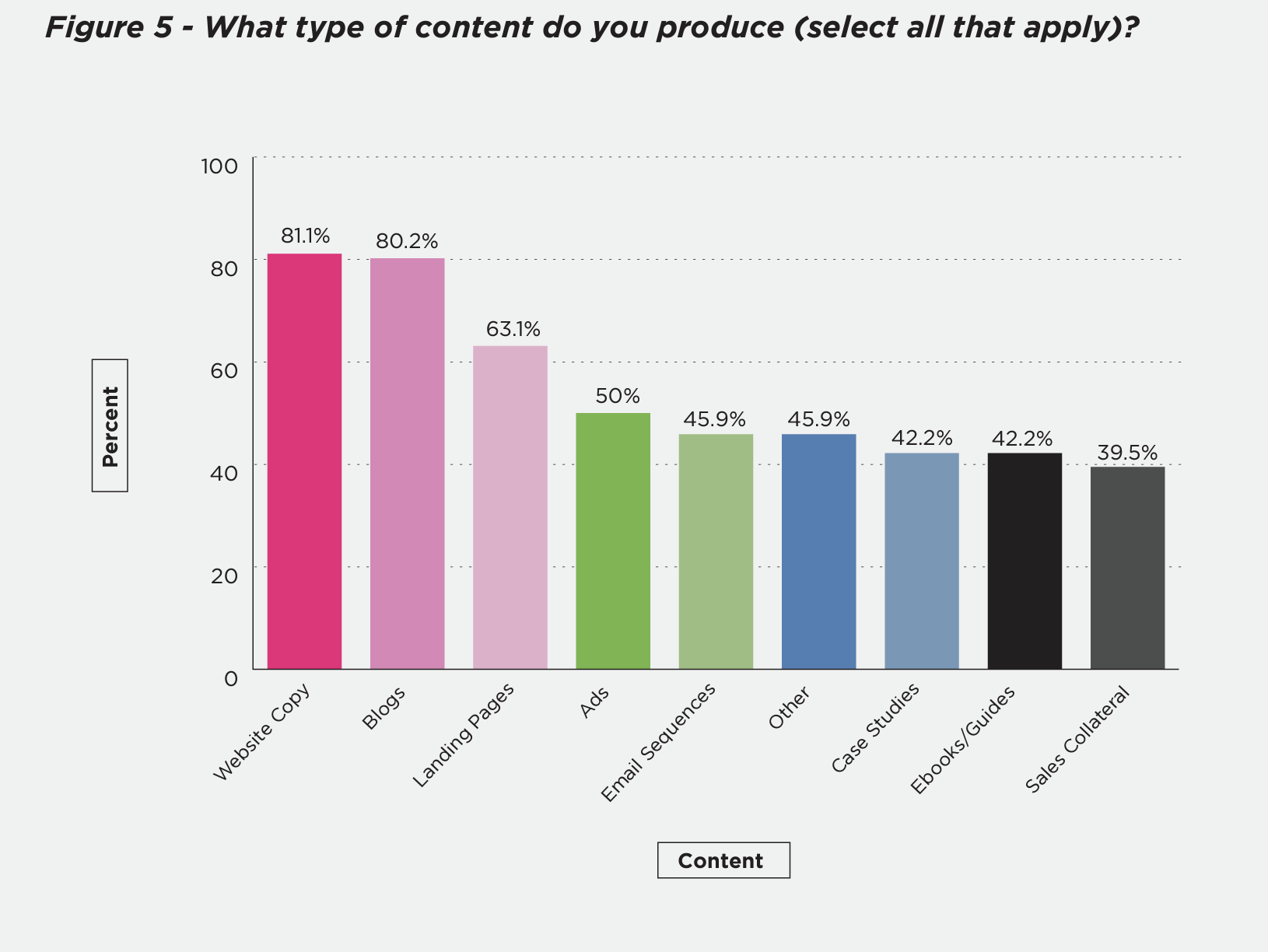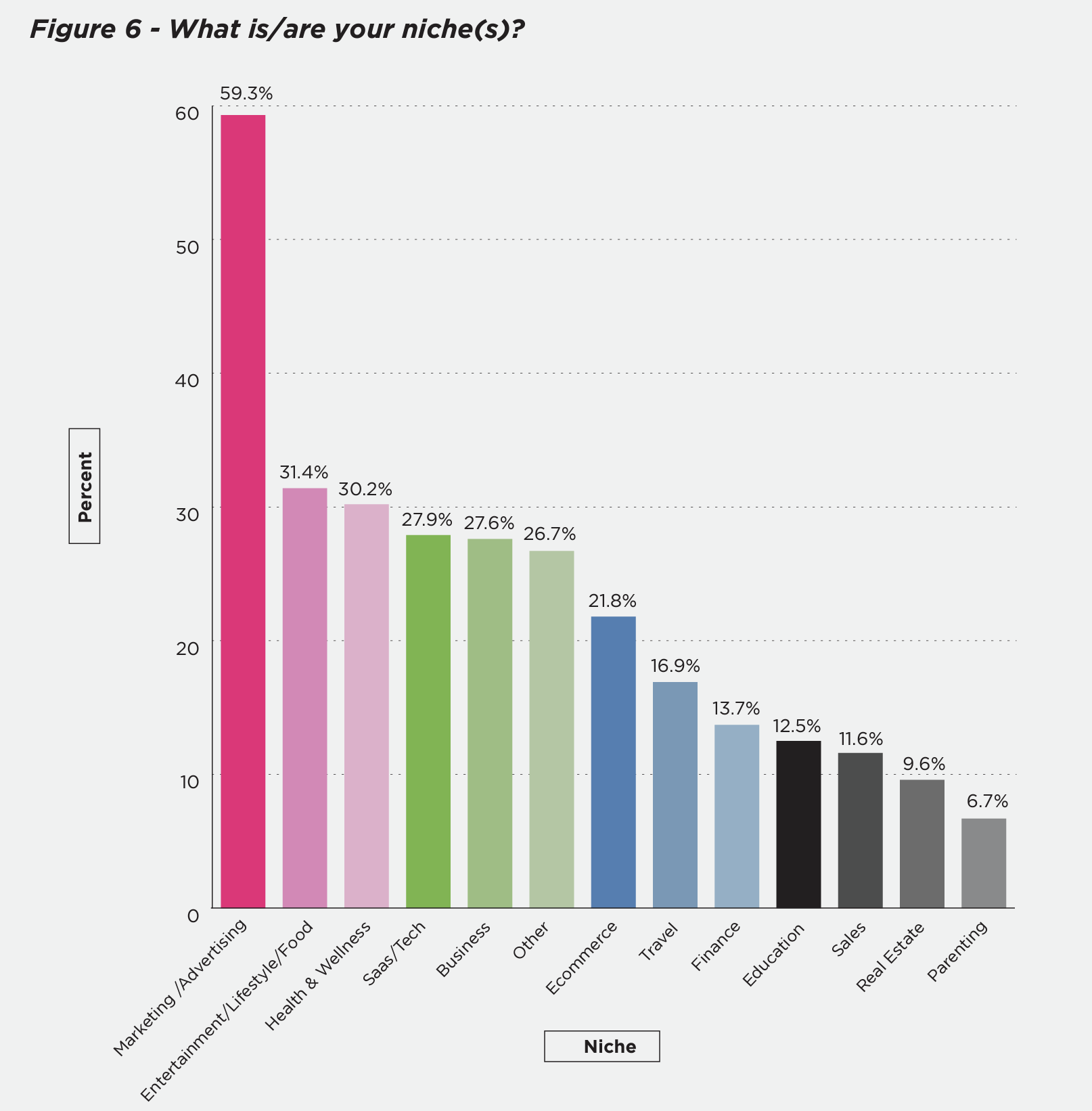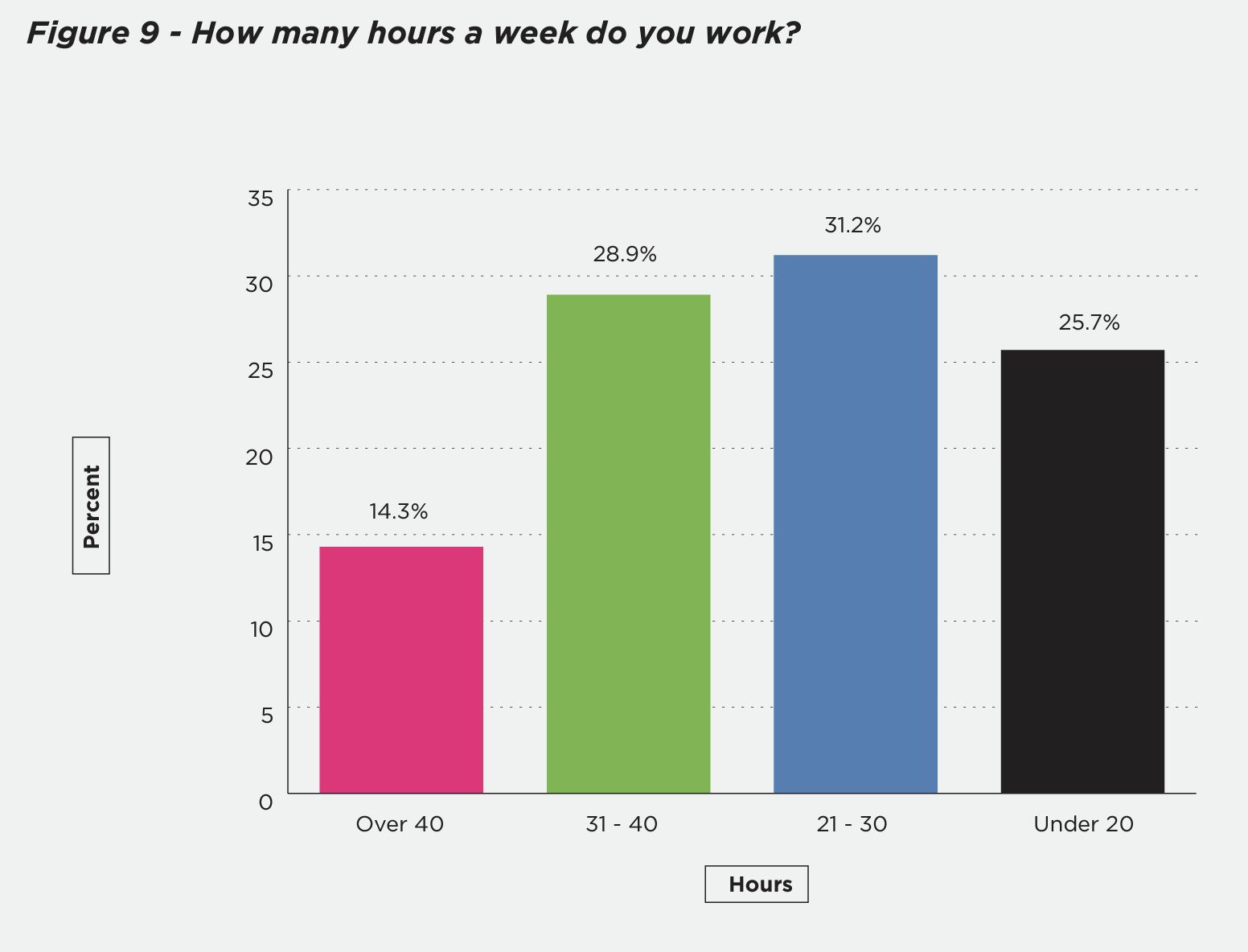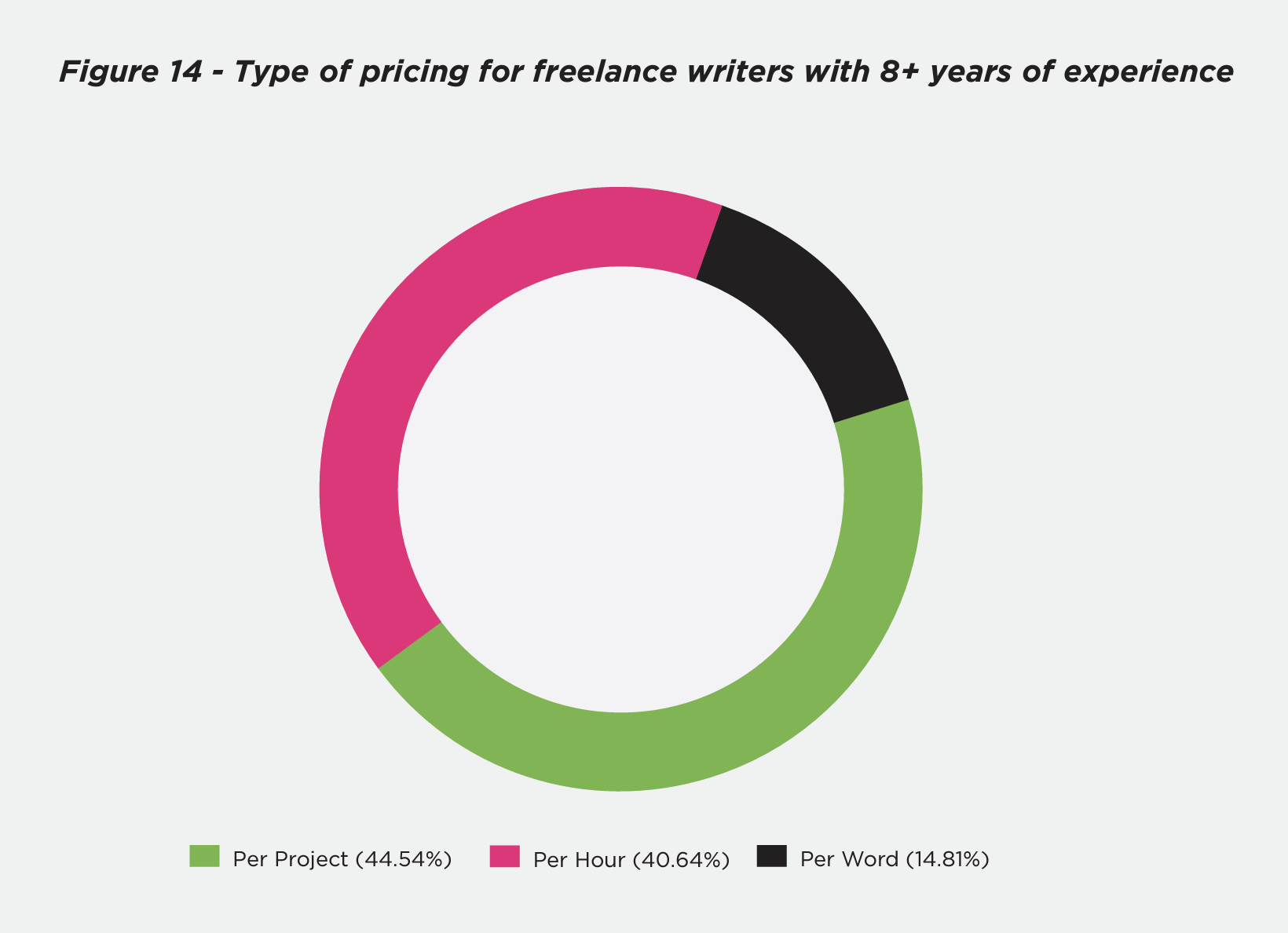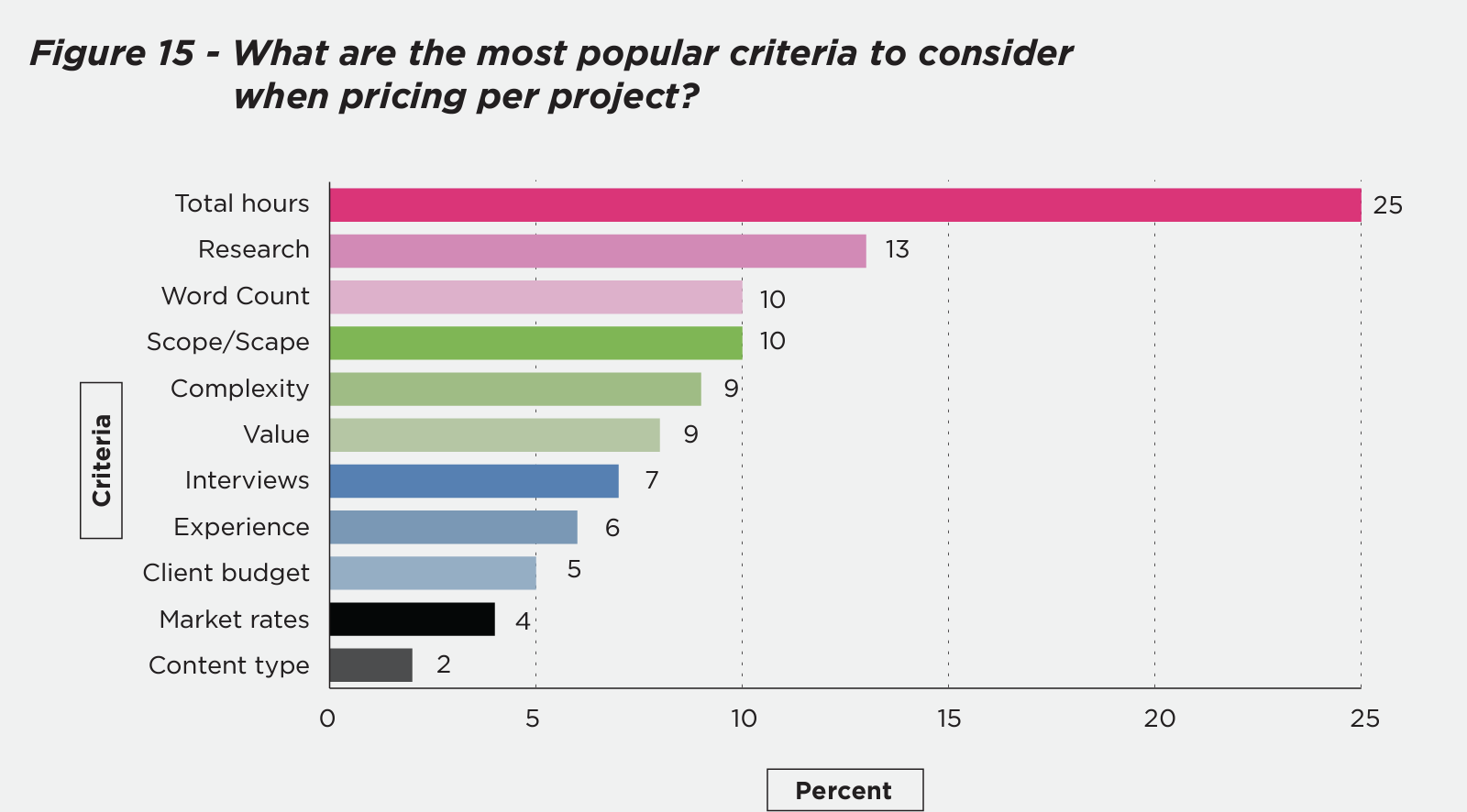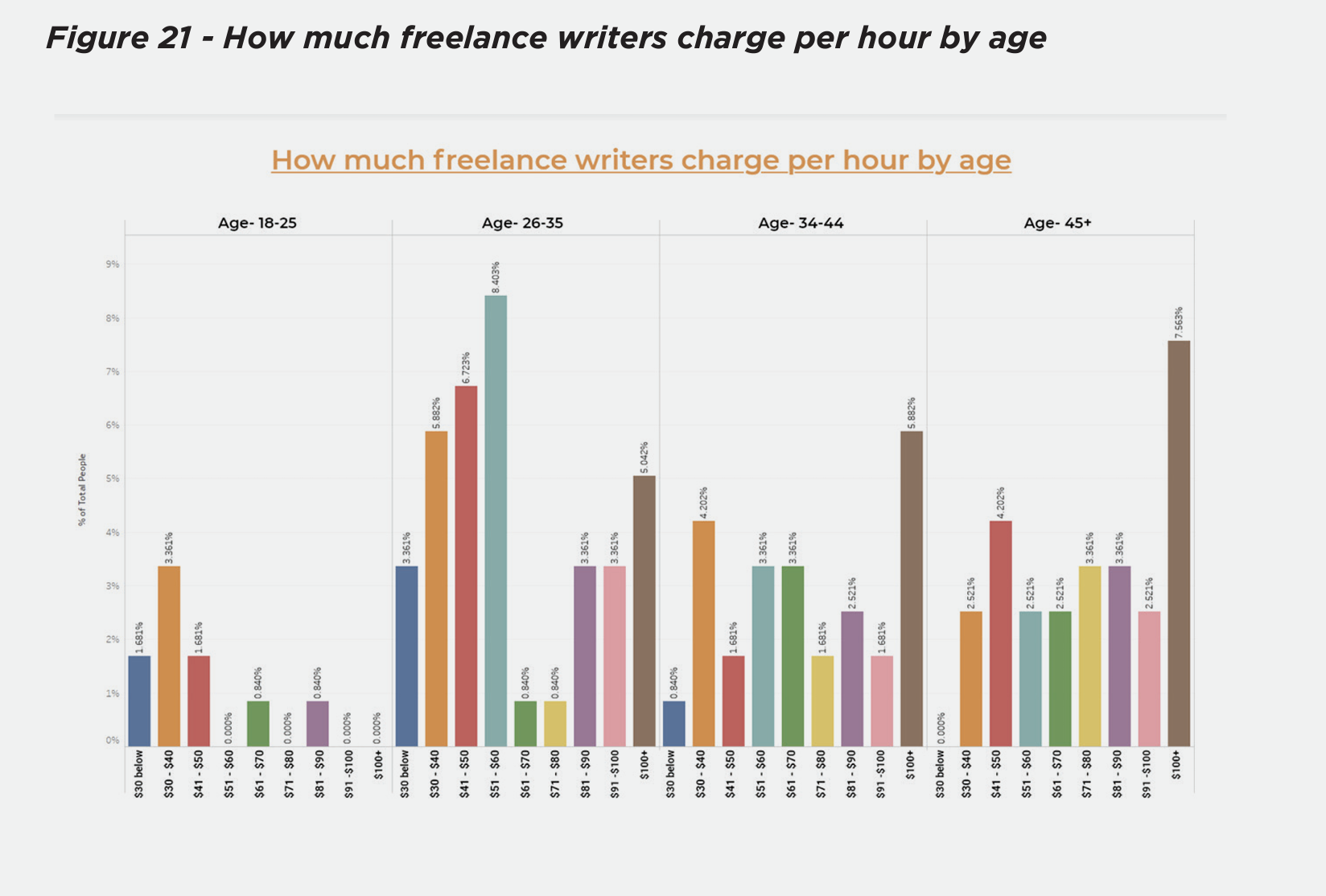When I first started freelance writing, I scoured all the popular copywriting blogs and books to answer my three most pressing questions:
How much should I charge for my services?
How much do other freelance writers charge and what is their project rate?
Am I charging low rates?
While there were some available resources, they weren’t comprehensive or had such wide ranges that the information wasn’t helpful.
My goal in conducting this survey was to reach out to a network of successful freelance writers to get detailed insights and numbers on:
How people price their writing jobs (e.g., per project, per word, per hour)
What criteria freelancers use to set rates and charge higher rates
How much freelance content writers charge for different types of content
With the help of this data, I put together the following report so that other freelance writers and beginners can benchmark their rates against experienced writers.
As you read this study, keep in mind these findings aren’t hard and fast rules, and you’ll still find a lot of variation. However, these results will provide insight into where your prices fall in relation to other freelancers, and whether you need to ask your clients for more money (you do).
Participants
Here is a quick overview of how I determined my target sample size, how I found participants, and basic respondent demographics.
Target Sample Size
There are 57 million freelancers in the United States, according to recent research by Upwork.
When assuming 57 million serious freelancers, a 90% confidence interval, and a 5% margin of error, the suggested sample size was 268 participants.
The response to this survey was far more robust, with a total of 344 study participants.
Participant Selection
My goal was to capture responses from serious and high-quality freelance copywriters. As such, I worked hard to qualify potential participants before asking them to participate in the survey.
I first started by reaching out to my current professional network of freelance writers and SEO writers.
Next, I scoured LinkedIn and Twitter to find active, high-quality, career freelance writers and asked these professionals to participate.
About The Study Participants
I wanted to learn how much per word, per hour, or per project freelancers charged for projects or if they charged a flat rate (or flat fee) for content writing. I also wanted to understand if there were any relationships between how and how much people charged based on various demographics, types of writing, and professional factors.
Before delving too deep into the results of this freelance writer rates report, here is a look into the participant demographics and information about their professional experience.
What is your gender?
Out of the 344 study participants, 67% were female, 31% were male, and 1% preferred not to identify.
Which range best represents your age?
The most popular age range for freelance writers in this study was 26-35, representing nearly 40% of the participants.
The second-largest age range demographic was 35-44 (24%). The third was freelancers over 45 (23%), and the least prevalent age range was 18-25 (10%).
Only 1% of the respondents preferred not to disclose their age.
What is your highest level of education?
The majority of the respondents had some form of college education (91%), including a bachelor’s degree, a master’s degree, or a doctorate. Only 6% of respondents had only a high school diploma, and 1% preferred not to say.
The most popular highest form of educational degree for freelance writers was a bachelor’s degree (69%), followed by a master’s degree (20%), and, finally, a doctorate (1%).
How many years of professional writing experience do you have?
Most survey respondents had over 8 years of professional writing experience, representing 46% of the participants, 22% had 5-8 years of experience, 17% had 3-5 years, and 14% were newbies and had 1-3 years of professional writing experience.
What type of content do you produce (select all that apply)?
Not only did I want to know how much experience freelance writers had, but I was also interested in learning the type of content these writers typically produce.
Respondents were encouraged to select as many content types as applied to their freelance writing services.
The top three most popular content types were website copy (81%), blog posts (80%), and landing pages (63%).
What is/are your niche(s)?
I also asked respondents to indicate their freelance writing niche between twelve popular niches. The most popular niche was marketing/advertising (59%), followed by health and wellness (31%), and entertainment/lifestyle (30%).
This information was imperative to help me cross-analyze per project, per word, and per hour data.
General Results
Part of learning how much freelance writers charge includes learning how freelance writers price their projects, and what criteria they use to price projects.
To get accurate answers to these questions, I captured both quantitative and qualitative data. Let’s take a closer look at some of the most interesting data points.
1. Most freelance writers (40%) price per project
The most popular way freelance writers price their work is per project. Forty percent of participants indicated they price work on a per-project basis. Considering website copy was the most popular type of content, this isn’t surprising.
2. Only 18% of freelancers price per word
The data also showed the least popular way to price work was per word (18%), even less popular than hourly pricing (38%). This did surprise me, considering the second most popular type of content was blog content, which seems to be the easiest type of content to price per word.
3. Most freelance writers work 21-30 hours a week
The distribution between how many hours a week freelance writers work was relatively equal. However, 21-30 hours came out on top, representing 31% of the respondents.
4. 66% of freelancers find new work via client referrals, 57% through referrals from their freelance colleagues, and 46% through networking sites
Sixty-six percent of freelance writers said they find clients through client referrals. The second most popular way to find clients is through referrals from freelance colleagues (57%), and the third most popular method is via professional networking sites (46%).
The power of a freelance writer’s network can not be understated, as the qualitative data in this study showed. Here is some advice about building a network from top-earning freelance writers in this study:
“Former bosses and coworkers have been my #1 source of future clients. If possible, work full time before freelancing so you can begin building a solid network.”
“Connect with other freelancers who do what you do or serve similar clients differently (e.g., a designer, business coach, etc.). Get to know them on a personal level and look for ways to support them genuinely. Often, referrals will grow organically from there.”
“Network like crazy and cultivate good relationships with clients once you are working on a project. You never know where it might lead. Look for interesting opportunities that will help you produce strong work samples.”
5. The majority of freelance writers (63%) juggle between 1-3 clients at the same time
Sixty-three percent of freelance writers have anywhere between 1-3 clients at the same time. This is an important number to know when pricing freelance writing projects.
When you know how many clients you can expect on average, and how many hours you plan to work, you can determine how much you will need to make from each client to support your new flexible lifestyle. Knowing these numbers will also help you understand what type of clients to pursue.
6. The majority of freelance writers (58%) juggle between 1-3 projects at a time
Fifty-eight percent of freelance writers work on 1-3 projects at the same time. How many projects you can handle at a time is another critical metric.
Knowing how many clients you have, how many hours you want to work, and how many projects you can handle will help guide your prices.
Now that we’ve talked about some of the most interesting data points from the study, let’s get into the nitty and gritty of the study: how much people charge per project, per hour, and per word.
Per Project Results
Overall, the most popular way for all freelance writers to charge was per project (40%). Per hour was the second most popular method for freelance writers to charge clients (38%), and per word was the least popular way to charge clients (18%).
How do freelance writers price projects?
It’s also interesting to note that per project was the most popular way for high-earning freelance writers with 8+ years of experience to price their work.
Type of pricing for freelance writers with 8+ years of experience
Pricing Per Project Overview
Since freelance writing projects vary drastically depending on different variables, I opted to capture and code qualitative data, instead of creating a complicated and potentially misguided questionnaire.
A qualitative approach helped me eliminate my personal research biases, keep the questionnaire shorter for higher completion rates, and tailor my analysis based on natural responses.
Naturally, there are limitations to a qualitative question on a survey, including:
It’s time-consuming
It can be difficult to verify results
Two qualitative questions don’t elicit as in-depth and thoughtful of a response as an interview would
Despite these limitations, I was able to capture, code, and quantify insightful and helpful data on the following:
Criteria for pricing per project
Average price per project by content type
The median price per project by content type
Let’s take a closer look. Drum roll, please…
What Are the Criteria for Pricing Per Project?
Out of the 40% of respondents that price per project, the majority offered robust details on the criteria they used to determine their rates.
I used frequency analysis to determine what factors people consider when pricing their projects. I also used a weighted scale to show the most frequently used criteria to the least. Here is what I found.
What are the most popular criteria to consider when pricing per project?
The top 5 criteria freelance writers use to determine per project prices are:
Hours required to complete the project
Research involved
Total word count
Scope or scale of the project
The complexity of the product
If you are new to freelance writing or are considering switching to a per-project pricing model, consider these factors when putting together your proposals.
How Much Do Freelance Writers Charge Per Project?
Freelance writers offered specific monetary numbers on the following types of content:
Landing pages
Blog posts
Website copy
Email sequences
White papers/Guides/eBooks
Case studies
Ads
Sales letters
There wasn’t enough qualitative data to show statistical significance for different groups (e.g., gender, niche, experience, etc.), so the following averages represent the data provided by all writers in the study.
Since blog post data was robust and because blog posts vary significantly in scope and word-length, I divided the blog post pricing data into three categories: low price, average price, and a higher price.
I also eliminated any ridiculous outliers. For example, if someone said they charged $25 for a blog post, the data point went out the window.
Here are the average price and median price points for people charging per project.
Average and median rates for per project
Per Hour Results
The second most popular way freelance writers priced their projects was per hour. Nearly 39% of the respondents said they priced their projects by the hour.
Percentage of freelancers that price per hour
Let’s take a closer look at how much freelance writers charge per hour and other interesting data points.
What do freelance writers charge per hour?
The data showed a wide variation in how much freelance writers charge per hour, but here are some of the most notable data points.
1. The largest group of freelance writers that charge per hour charge over $100 per hour.
While the freelance writers that charge per hour, charge different rates, there is good news. The most popular hourly rate for freelance writers was over $100.
How much do you charge per hour?
2. Over 60% of freelance writers charge over $50 per hour.
It’s also worthy to note that slightly over 60% of all freelance writers that charge per hour are charging at least $50 per hour.
Percentage of freelance writers that charge at least $50/hour
3. More experienced freelance writers are charging higher hourly rates.
The data showed that most freelance writers with over 8 years of experience are charging over $100 per hour, which is much more than people with less experience are charging.
How much freelance writers charge per hour by experience level
4. Older freelance writers charge more per hour
No writers between the ages of 18-25 reported that they were charging over $91 an hour, and no writers above the age of 45 were charging less than $30 per hour.
How much freelance writers charge per hour by age
5. Freelance writers with a bachelor’s degree are charging more per hour than those with a high school diploma
The majority of participants in this study (69%) reported that a bachelor’s degree was the highest educational degree attained. Twenty percent said they earned a master’s degree, 6% a high school diploma, and 1% a doctorate.
What is your highest level of education?
The data showed that the largest group of freelance writers with a bachelor’s degree are charging over $100 per hour.
How much freelance writers charge per hour by education
The data is a bit slim to be truly representative of how much freelance with a high school diploma and a doctorate are charging.
However, this study shows those with a high school diploma are charging a max of $60 an hour, and freelance writers with a doctorate are charging no more than $80 an hour. Again, these particular data points are slim, so take them with a grain of salt.
Per Word Results
The least popular way for freelance writers to price their projects was per word, with only 18% of the respondents reporting they charge per word.
Percentage of freelance writers that price per word
Let’s take a closer look at how much freelance writers charge per word and other interesting data points.
1. The majority of freelance writers are only charging up to .35 cents per word and 49% are only charging up to .25 per word
Most participants (49%) that charge per word are only charging up to .25 per word, and the majority (over 69%) are only charging up to .35 per word.
How much do you charge per word?
This was surprising considering how much more freelance writers that price per project and per hour are charging.
2. Freelance writers with more experience are charging over $1 per word
While freelance writers, overall, are charging less per word, the data shows that freelance writers with more experience are charging much more per word than those with less experience.
How much freelance writers charge per word by experience level
In fact, the trend in the data shows the per word price progression. Typically, the more experience a freelance writer has, the more they are charging per word.
One freelance writer involved in the study offered helpful insight into how freelance writers can progressively increase their rates as they get more clients.
This writer said, "price based on your demand and experience, and increase your rates by 10% for every three inquiries."
If you plan to price per word, this is a smart strategy for increasing your rates as you gain more experience.
3. 97% of freelance writers that charge per word write blog posts (but not exclusively)
The data also showed that 97% of freelance writers that charge per word write blog posts (but not exclusively). Three percent indicated they wrote “other” content that wasn’t either blog posts, landing pages, ebooks, case studies, email sequences, ads, sales collateral, etc.
Out of all the various content types, charging per word for blog posts makes the most sense. However, many freelance writers that write blog posts mentioned they charge per project and use a word count range instead.
For example, one freelance writer explains blog post pricing as follows. “I use word count ranges, so a 1,000-word post might cost $750, which bumps up to $1000 for a 1250 word post. I charge extra for meetings over 30 minutes a month, and source interviews ($100 a piece).”
Another freelance writer uses a calculator to price projects and typically uses the following range for blog posts:
1000-1500 words: USD 600
1500-2000 words: USD 700
2000-2500 words: USD 800
2500-3000 words: USD 900
These ranges aren’t how you have to price your projects, but they are good examples of how a word range model works. If you currently price your blog posts per word, consider looking into pricing blog posts with a range.
Advice from Professional Freelance Writers
As part of the study, I also wanted to include expert recommendations. I received numerous excellent responses, but here are the most exciting and helpful responses from your fellow writers.
I divided the advice up into the following categories:
Portfolio advice
Networking advice
Rates advice
Pitching advice
Portfolio Advice
“Create a clean, polished portfolio with writing examples. Even if you haven't been published or hired before, create a robust portfolio that shows off your writing chops.”
“Have zero tolerance for typos on your portfolio website, LinkedIn profile, and introduction message to potential clients! Everyone makes mistakes, but not you. You can make mistakes on projects, and your clients will forgive you if you've done the groundwork of making a perfect first impression.”
“I would recommend having a website. A website helps you build credibility and show off your copywriting skills.”
Networking Advice
“I wouldn't recommend people start by freelancing. You gain valuable experience working for companies and can build a side gig with freelancing during that time. A company also gives you insider info, builds your network, and allows you to understand how organizations work internally. All of that knowledge is incredibly helpful for your own freelance business, but also in working with and managing clients in the future. Don't start out freelancing. Start out working in an organization, build empathy for those employees, understand exactly what it is they need and why, and then hit those goals without them asking every single time. When you make your client's life easier, you have a client for life.”
“Diversify your reach. Network on social media and in person. Reach out to acquaintances and let them know what you are doing and see if they know somebody looking.”
“As a writer, anyone can be your new client. Connections can happen in unexpected places. Stay open.”
“Network like crazy and cultivate good relationships with clients once you are working on a project. You never know where it might lead! Look for interesting opportunities that will help you produce strong work samples.”
“Have a vibrant LinkedIn profile with a professional photo. Make at least 20 contacts per day. Post at least five days per week: original articles weekly; post relevant memes; curate and comment on others' articles. Respond to others' posts and articles like crazy. Let people know you're a writer! Have an active presence on Facebook and Instagram. Most of all, though, be professional!”
“If you're looking to freelance in advertising, reach out to creative directors and creative recruiters. Depending on your relationship with them, either outright selling your services to them or a softer approach is ideal.”
“Join a local organization so you can meet people like yourself—and people who work in your industry but not your specific field. The whole of my freelance work comes from referrals from others in my industry—designers, filmmakers, etc.”
“Word of mouth is everything. Keep in touch with old coworkers—not just about work—you'll be top of mind when a project comes up. Never burn bridges. Also, help other people out when you can, not expecting anything in return. It will come back to you.”
Rates Advice
“Don't be afraid to charge the industry standard. When you undercut yourself, you also make it difficult for others to charge reasonable rates. Understand the industry standard and develop your rates from there. When you land on a number you're comfortable with (and you've bounced it off a few people), don't be afraid to say it with your chest.”
“As you learn and get better, raise your rate to reflect this. Don't be stuck taking any project and charging bargain rates. Know that you are worth something and charge for it.”
“Avoid doing free samples. Also, encourage previous clients to share their testimonial/feedback because this could go a long way in winning you more clients.”
“Don't ever offer to do a project for free. It can be a major turn-off when pitching to clients. *Free* often reads: ‘I’m new and don't know what I'm doing’ or ‘I’m going to be a time suck because I'll need a ton of hand-holding.’ It also undervalues your worth. Good copywriting isn't just a skill—it's a talent, an art form, and even a science. Any client that doesn't realize that isn't worth your time.”
“Don't be afraid to charge what you are worth from the very beginning. A lot of new work comes from referrals, and if you undercharge, you may get stuck with a rate that is not sustainable. Don't be afraid to charge what you deserve.”
“Find out what others are charging. Charge 10% more. It's scary, but you'll gain confidence once clients start paying you what you ask.”
“Avoid content mills.”
Pitching Advice
“Consistency is key. Make sure that you send out 20-30 cold pitches a day to keep the pipeline filled.”
“Be persistent. Put out a ton of feelers and don't get hung up on anyone lead, just keep pitching and approaching more potential clients.”
“Be specific. It's much easier to sell blog posts than to sell ‘I’ll write whatever you need.’ Be unconventional on your job searching. Reach out to recruiters directly.”
“If you think you're sending enough cold pitches/LOIs/etc., You're definitely not! Send as many as you possibly can, and then send some more. It's one of the best ways to find new clients, especially if you don't have a network that can refer you out yet.”
“Make your pitch about them, not about you. People care less about who you are and what your experience is and how you can help them. Also, be willing to do a little work upfront pro bono if it will help you land a paying gig.”
“As long as your pitch is well researched and addresses a real need - you'll come across looking like a badass, action-taking, freelancer who isn't afraid to go after what she wants.”
I couldn’t have said it better myself.
Conclusion: How much should freelance writers charge?
Well, it took a lot of time to put together this report, and I got temporarily banned on LinkedIn from sending any more connections. But it was worth it!
The most interesting and shocking findings to me include:
How many freelance writers are charging per hour as opposed to per project
How low most per-word rates are (boost those prices, peeps)
How high hourly rates are (good work)
How “hours spent” on a project is the most important criteria for those charging per project
How the majority of new clients come from referrals.
I hope this report provided some valuable insight to help you benchmark your rates.
For more information on how to start a freelance writing business, please visit the products page.
For freelance tips and jobs, subscribe to the newsletter.
